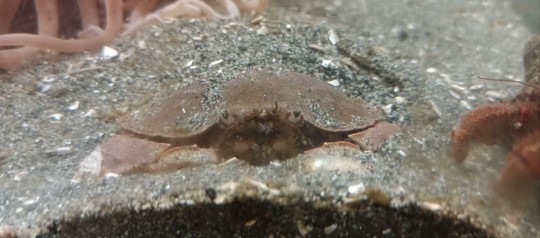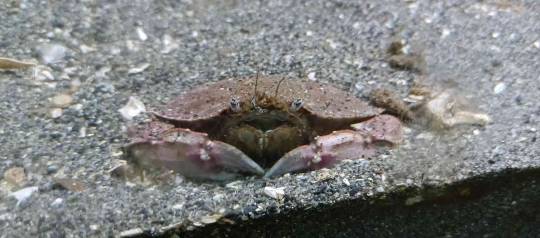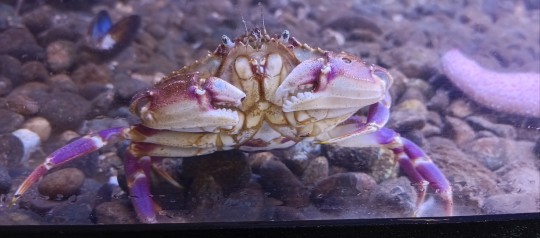#metacarcinus gracilis
Photo

making merriment from misery
#red rock crab#cancer productus#graceful crab#metacarcinus gracilis#MaST Center aquarium#shitpost#meme#marine biology
217 notes
·
View notes
Text

Today's crab is: needs a hand
(Graceful crab, Metacarcinus gracilis)
#crab#graceful crab#crabby submission#submitted by lepidospetta bilineata#same problem as before :/#making sure this gets out there tho
264 notes
·
View notes
Text
Octopuses May Go Blind As Climate Change Sucks Oxygen Out of the Ocean


Turning light particles into visual details is effort, and your body counts on oxygen to get the task done. This holds true whether you stroll the arrive on 2 limbs or swim through the sea with 8.
In reality, according to a current research study in the Journal of Speculative Biology, the quantity of oxygen readily available to marine invertebrates like squids, crabs and octopuses may be even more crucial to their vision than formerly believed. In the research study, released online April 24, scientists saw a considerable drop in retinal activity in 4 types of marine larvae (2 crabs, an octopus and a squid) when the animals were exposed to reduced-oxygen environments for as low as 30 minutes. [8 Crazy Facts About Octopuses]
For some types, even a tiny drop in oxygen levels led to practically instant vision loss, ultimately triggering near-total loss of sight prior to the oxygen was cranked back up once again.
According to lead research study author Lillian McCormick, a doctoral prospect at the Scripps Organization of Oceanography in La Jolla, California, some type of vision disability may be an everyday reality for these types, which move in between the ocean’s extremely oxygen-saturated surface area and its hypoxic (low-oxygen) depths throughout their day-to-day feeding regimens. And as ocean oxygen levels continue to drop around the world, in part due to climate change, the threats to these animals might heighten.
“I am concerned that climate change is going to make this issue worse,” McCormick informed Live Science, “and that visual impairment might happen more frequently in the sea.”
To poke a cephalopod in the eye
For the brand-new research study, McCormick and her group examined the market squid (Doryteuthis opalescens), two-spot octopus (Octopus bimaculatus), tuna crab (Pleuroncodes planipes) and elegant rock crab (Metacarcinus gracilis). These types are all regional to the Pacific Ocean off of Southern California, and they all take part in an everyday diving regular referred to as vertical migration. By night, they swim near the surface area to feed; by day, they come down to higher depths to conceal from the sun (and the starving predators it brings).
As these animals move up and down the water column, the oxygen accessibility modifications considerably. The ocean is loaded with oxygen near the surface area, where air and water fulfill, and considerably less saturated with oxygen at 165 feet (50 meters) listed below the surface area, where numerous shellfishes and cephalopods conceal away throughout the day. [No, Octopuses Don’t Come from Outer Space]
To discover whether these day-to-day swings in oxygen affect the animals’ vision, McCormick connected little electrodes to the eyes of every one of her test larvae, none of which determined longer than 1.5 inches (4 millimeters). These electrodes tape-recorded the electrical activity in each larva’s eyes as its retinas responded to light —”kind of like an EKG [electrocardiogram], however for your eyes rather of your heart,” McCormick stated.
Each larva was then positioned in a tank of water and made to take a look at a brilliant light while the water’s oxygen level was gradually reduced. Levels fell from 100% air saturation, oxygen levels you’d anticipate to discover at the surface area of the ocean, down to about 20% saturation, which might be discovered at the most affordable depths of an invertebrate’s vertical migration. After 30 minutes of this low-oxygen condition, the oxygen levels were increased back to 100%.
While each of the 4 types revealed a somewhat various tolerance, all 4 took a significant blow to vision when exposed to the low-oxygen environment. In general, each larva’s retinal activity dropped in between 60% and 100% in low-oxygen conditions. Some types, especially the market squid and the rock crab, showed so delicate that they began losing their vision as quickly as the scientists began reducing the oxygen in the tank.
“By the time I reached the lowest oxygen levels, these animals were almost blinded,” McCormick stated.
The bright side is that the vision loss wasn’t irreversible. Within about an hour of going back to a completely saturated oxygen environment, all of the larvae restored a minimum of 60% of their vision, with some types getting better to 100% performance.
Blind in the water
It’s most likely that due to the fact that the Pacific naturally experiences a lot of low-oxygen conditions near Southern California, these extremely delicate types come to grips with some type of vision disability every day, McCormick stated. (More research study is required to understand for sure, though.) This disability may not matter much under low-light conditions and at much deeper depths, however might capture animals by surprise if lower oxygen conditions dominate closer to the surface area. Ideally, McCormick included, these at-risk types are naturally establishing avoidance habits so that they swim to higher-oxygen parts of the ocean when extreme vision disability sets in.
Nevertheless, McCormick stated, fast deoxygenation triggered by climate change might make it harder for these types to adjust. According to a 2017 research study in the journal Nature, overall ocean oxygen levels have actually decreased by 2% worldwide in the last 50 years and are forecasted to decrease by as much as an extra 7% by the year 2100. Climate change is a considerable element driving these losses, the Nature research study discovered, particularly in upper parts of the ocean, where the larvae McCromick studied tend to invest most of their lives.
This warming-induced deoxygenation — paired with natural forces like wind and water blood circulation patterns that make near-surface oxygen levels irregular in the area — might lead to more susceptible animals losing their vision when they require it most. At-risk animals might end up being less efficient at searching for food near the surface area, and may miss out on subtle indications of predators in their middle, McCormick stated. It’s a grim possibility — nevertheless, more research study is required to identify the quantity of oxygen-related vision loss it truly takes prior to these animals make possibly hazardous errors.
“If I take out my contact lenses at home and walk around, I might stub my toe, but I’ll get by,” McCormick stated. “The next question is, how much retinal impairment equals a change in visual behavior?”
Initially released on Live Science.
document.addEventListener("DOMContentLoaded",function()if(document.getElementById("comments"))var listener=function()var rect=document.getElementById("comments").getBoundingClientRect();if(rect.top<window.innerHeight)loadAPI();window.removeEventListener("scroll",listener);window.addEventListener("scroll",listener));function loadAPI()var js=document.createElement("script");js.src="http://connect.facebook.net/en_US/sdk.js#xfbml=1&appId=131734303545872&version=v2.4";document.body.appendChild(js) var Purch=Purch||;Purch.queue=Purch.queue||[];Purch.queue.push([["jquery","Purch/UI/Poll"],function($,Survey)$("[data-poll]").each(function()var e=this;var oconf=$(this).information("poll")?$(this).information("poll"):;oconf["element"]=e;var survey=brand-new Survey(oconf))]);
New post published on: https://livescience.tech/2019/05/16/octopuses-may-go-blind-as-climate-change-sucks-oxygen-out-of-the-ocean/
0 notes
Text
if you train graceful crabs to take food from you they WILL start trying to eat your whole hand every time. that's just how they be
#they are surprisingly difficult to shake off#you idiot I dropped the food I don't have it anymore let goooo#metacarcinus gracilis#quilltxt
1 note
·
View note
Photo

Graceful Rock Crab (Metacarcinus gracilis)
Also known as the Slender Crab, the graceful rock crab is a species of Cancrid crab which is native to the Pacific coast of North America, ranging from Alaska south to southern Baja California. Juvenile M. gracilis are noted for “riding” jellyfish (typically Phacellophora camtschatica) where they will both steal some of their food and protect them from parasites. M. gracilis is fairly similar to the other species in its genus M. magister but the two can be distinguished by the fact that M. magister has white tips to its chelae.
Classification
Animalia-Arthropoda-Crustacea-Malacostraca-Decapoda-Brachyura-Cancridae-Metacarcinus-M. gracilis
Image: Dave Pena
#Metacarcinus gracilis#Graceful Rock Crab#Slender Crab#Arthropoda#Crustacea#Malacostraca#Decapoda#Brachyura#Cancridae#Metacarcinus#Crab#North America#Pacific#Ocean
153 notes
·
View notes
Photo


Graceful Crab (Metacarcinus gracilis)
#metacarcinus gracilis#graceful crab#crustacean#brachyura#cancridae#pnw#wa#washington#puget sound#salish sea#whulge#les davis#tacoma#crab#underwater#photography#scuba#diving#ocean#marine biology
93 notes
·
View notes
Text


Our Cancer productus and one of our Metacarcinus gracilis. Cozy as a crab!!!! 🦀 🛏️
#mast center aquarium#graceful crab#red rock crab#cancer productus#metacarcinus gracilis#crab#crustacean#decapod#brachyura#cancridae
20 notes
·
View notes
Photo


an important meeting and a cozy crab.
12 notes
·
View notes
Text
youtube
I got my ROV back together and took her out for an expedition! It's been almost 5 whole months since her last foray! Many sea cucumbers, flatfish, sculpins, and crabs to be seen!
#rov#marine biology#point defiance marina#flatfish#sculpin#puget sound#ocean exploration#english sole#parophrys vetulus#rock sole#lepidopsetta bilineata#red rock crab#cancer productus#graceful crab#metacarcinus gracilis#dungeness crab#metacarcinus magister#staghorn sculpin#Youtube
5 notes
·
View notes
Video
youtube
Footage from my dive this morning!
Rock soles, speckled sanddabs, helmet crabs, graceful crabs, red rock crabs, longnose crabs, snake pricklebacks, anemones, and more await you beneath the emerald sea surface off the shore of Steilacoom, WA.
#steilacoom#pnw#pacific northwest#ocean#sea#puget sound#sunnyside beach park#flatfish#crab#crustacean#brachyura#pleuronectodae#lepidopsetta bilineata#rock sole#speckled sanddab#pacific sanddab#graceful crab#metacarcinus gracilis#cancer productus#sand lance#gunnel fish#penpoint gunnel#saddleback gunnel#fish#marine biology#scuba#diving#eelgrass#seagrass
6 notes
·
View notes
Text

This is Gracie, one of our graceful crabs*(Metacarcinus gracilis)* at the aquarium. She decided it would be fun to walk up to my scraper and attack it.
#eukarya#animalia#arthropoda#crustacea#decapoda#cancridae#metacarcinus gracilis#graceful crab#mast center aquarium
4 notes
·
View notes
Video
youtube
Parophrys vetulus, Lepidopsetta bilineata, Citharichthys stigmaeus, Metacarcinus magister, Metacarcinus gracilis, penpoint gunnel, crescent gunnels, unidentified sculpin, jellyfish, and more can be found beneath the surface of Les Davis Marine Park!
The park is most notable for its concrete reef, located about 18m down near a marker buoy. I did not visit the reef, unfortunately, due to low visibility conditions that made me uncomfortable going deeper than 9m. Perhaps next time I will record a definitive set of wildlife seen on the reef! Among them are rockfish, lingcod, and Metridium farcimen in the hundreds!
#parophrys vetulus#lepidopsetta bilineata#cancer productus#metacarcinus magister#metacarcinus gracilis#red rock crab#graceful crab#dungeness crab#flatfish#cancridae#pleuronectodae#crabs#jellyfish#nudibranch#sculpin#scorpionfish#cnidarians#pnw#wa#washington#whulge#salish sea#les davis#tacoma#underwater#photography#videography#scuba#diving#penpoint gunnel
1 note
·
View note
Text

Today's crab is: comfy cozy
(Graceful crab, Metacarcinus gracilis)
#crabby submission#crab#graceful crab#submitted by lepidospetta-bilineata#sorry that it's not like. and actual submission? it was REFUSING to post so i had to do this instead :(
216 notes
·
View notes
Text
I am happy to report that our starry flounders (Platichthys stellatus) are eagerly eating and growing! They are also overcoming their fear of people. This progress is heartwarming.
The graceful crab (Metacarcinus gracilis) that shares their tank emerged from beneath the sand (in a fashion I'd consider rather epic) to join the feast. I feed the animals individually with large tweezers, and when I offer this crab a piece of oyster flesh, he scrambled and grabbed for it so vigorously that he clung to the tweezers and wouldn't let go. I nearly lifted him out of the tank. It was hilarious.
He ate as though he'd never ate before in his life, He would tear the flesh into two pieces, and eat the larger piece, instead. The logic is impeccable.
I am telling you, forget cetaceans, pinnipeds, and elasmobranchs; crabs are the most charismatic of the marine fauna. Offer them food, and you will see!
1 note
·
View note